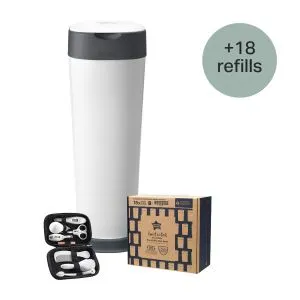
Ultimate XL Nappy Disposal Bundle with 18 Refills
Bundle & Save 40%
Subscription orders can be cancelled at anytime. Free delivery on all subsequent subscription orders. Find out more about subscriptions.
They’re easy and fuss free
Your products are automatically sent to you
You save up to 10% when you sign up for a subscription
You can cancel at any time

Mastered milk? Great! Now it's time to start mixing your baby's mealtimes up a bit. Introducing your baby to solid or textured foods (also known as weaning or complementary feeding) usually starts when they're around six months old.
You should introduce your baby to a varied diet alongside their usual breast milk or formula. In the beginning, you only need to give your baby solid or textured food once a day, at a time that suits you both.
This is your chance to introduce new flavours to the menu, and to encourage your mini-me to get the hang of chewing by doing less of the work for them and providing solid food or meals with lumpier textures. Weaning teaches your baby how to move solid food around their mouth, chew and swallow solid foods.
You may find your baby is ready for finger foods and now wants to hold the spoon and feed themselves which is both exciting and messy in equal parts. It is great to encourage independent feeding, but choking is still a risk so don't leave them alone while eating.
Other steps to prevent choking include:
When you begin weaning, you can go with your instincts, but also look out for the main signs of readiness to ensure that they're developmentally and physically ready to start having solid foods. They need to need to have an immune and digestive system that is ready to take more than milk alone and that is ready for a complex set of nutrients and compounds to break down and digest.
If they're ready, they will:
The following behaviours can be mistaken for signs of being ready for solid food:
Below you can find a weaning schedule and how much food to give your baby when weaning at different ages.
Moving on from purees really helps babies to enjoy a wide and varied diet, and the whole weaning process is all about the gradual transition to family foods. This includes a gradual transition through textures. Purees, to mashed foods to lumpy foods to solid foods.
When it comes to first finger foods, it's generally recommended to offer little one's finger foods that are baton-shaped (around the size and shape of an adult finger), and squidge-able between your finger and thumb so that your baby can squash the food in their mouth using their tongue and the roof of their mouth of gums.
Ideally finger foods should be sturdy enough to be held, but soft enough to be flattened with a little pressure. Avoid round shapes and firm foods and cut small round fruits like grapes, cherries, berries, strawberries, and cherry tomatoes into quarters.
Explore the Range
There are actually four types of feeding behaviours that babies use when they eat, suckling, sucking, munching and chewing. Suckling and sucking are innate but munching (between four and seven months of age) and chewing (around seven months of age) are learned as baby is introduced to a variety of food textures. For this reason, it's important to give babies smooth, mashed and lumpy textures, as well as an array of different finger foods to help them learn and develop during their weaning journey.